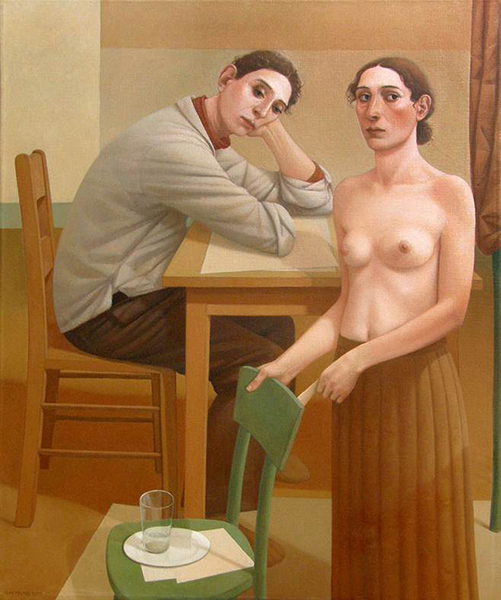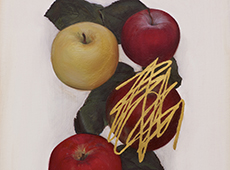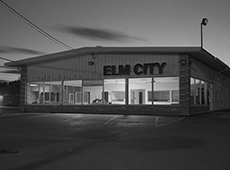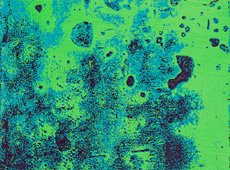Each of us will have a unique compilation of remembered sensations and it is how this material shapes our work that will distinguish my paintings from those of the next painter. We really don’t have all that much control over what we produce when we work from within. What unfolds on the canvas evolves slowly. My paintings take weeks or months to complete.

Alan Feltus, “The Young Man and the Flower Lady.” 2010. Oil on linen, 48 x 39 ⅞ inches.
© Alan Feltus. Courtesy of Forum Gallery, NY
February 2003, Assisi
These paintings are about many things and at the same time about nothing more than painting itself. They don’t have narrative content; they don’t tell stories. What the figures communicate is not knowable, not to me and therefore not to the viewer. Or perhaps I should say what is communicated is open to interpretation and as such there are endless meanings. Endless possible readings. They are quiet images with unspoken, and elusive meanings. They are abstract in the same way instrumental music is abstract. They convey something. They create a certain mood. We feel something when we slow down and focus on what a painting says. They are readable the way the world is readable to us. We need not ask how we should understand everything we observe.
Each of us will have a unique compilation of remembered sensations and it is how this material shapes our work that will distinguish my paintings from those of the next painter. We really don’t have all that much control over what we produce when we work from within.
I paint without models. I draw upon many kinds of sources, but largely those painters, from ancient to modern, whose works have taught me most throughout my career. They tend to be the painters who structure their paintings tightly. They are masters of much more than that but, it seems, always masters of composition. More than not, they also painted from within. Or perhaps they, like myself, are observing art and nature all the time while not in the studio, and then while painting rely on what has been internalized. Each of us will have a unique compilation of remembered sensations and it is how this material shapes our work that will distinguish my paintings from those of the next painter. We really don’t have all that much control over what we produce when we work from within.
What unfolds on the canvas evolves slowly. My paintings take weeks or months to complete. They have many layers of changes and then more layers of refinement before every element feels right in relation to every other. Form gradually defines itself in light, and light and color begin to work.
From a letter to Arden Eliopoulos. Assisi, May 2, 2001.
I think art wants to be something people can turn to for a kind of meaning in their lives, or for a calm place within the turbulence of our modern world. Art doesn’t have to explain our situation within the complexity of a chaotic and unstable society. Art can become social commentary, but it can also serve a much needed purpose, providing a place of refuge wherein one can find a reason, or justification, for all the battling we have to do, mentally or physically, most of every day of our lives. After all, we love the art of the past for itself, generally being ignorant of the context, the politics, let’s say, of the time and place in which it was made. We hold onto our favorite pieces in our favorite museums or churches, in our books, and we love to be moved by the beauty of something newly found. Art should have that kind of place in our lives. Art should be about transcendence. It should not merely reflect our surroundings like a mirror, adding to the clutter, but become something more wonderful, more meaningful than that. It wants to be remembered and returned to over and over again. Good art feeds us. It is so important.
From a letter to Joseph Jennings, July 27, 2000, Assisi
Yesterday I struggled more with the painting on my easel. There have been things about the space that hadn’t been working. Maybe it made some advances yesterday. Painting can move very slowly for me. Lani’s as well. But painting is the one thing I seem to have endless patience with. I know it wants to move slowly at times. There are so many days when nothing is resolved yet those days are necessary in order to progress beyond whatever it is that holds a painting back. The painting needs to reflect an inner self. It results from a meditative state, it seems. And those sleepy days at the easel when nothing seems to move ahead are essential. You understand all that quite instinctively, it seems to me.
Art should be about transcendence. It should not merely reflect our surroundings like a mirror, adding to the clutter, but become something more wonderful, more meaningful than that. It wants to be remembered and returned to over and over again. Good art feeds us. It is so important.
Editor’s Note:
Alan Feltus’s “Words from Letters” appear, from time-to-time, elsewhere on the web. We came across them some years ago on Alan’s site, then later on Frank Hobbs’s blog, a welcome and needed resource—and not just for Professor Hobbs’s students at Ohio Wesleyan University. For us here at Tilted Arc, Alan’s notes are an important staple in our ongoing conversation about the possibility of painting. They are also important starting points for our discussion on patience over provisionality, and of our steadfast view of art’s ability to transcend social commentary. We’re grateful to Alan for allowing us to republish his notes here.
Recommended Sites:
Alan Feltus: www.alanfeltus.com
Lani Irwin: laniirwin.com
Forum Gallery, NY: forumgallery.com
Subscribe to Tilted Arc
If you like this story, please consider subscribing. We are sticklers for privacy.
We will never sell or share your e-mail address.



